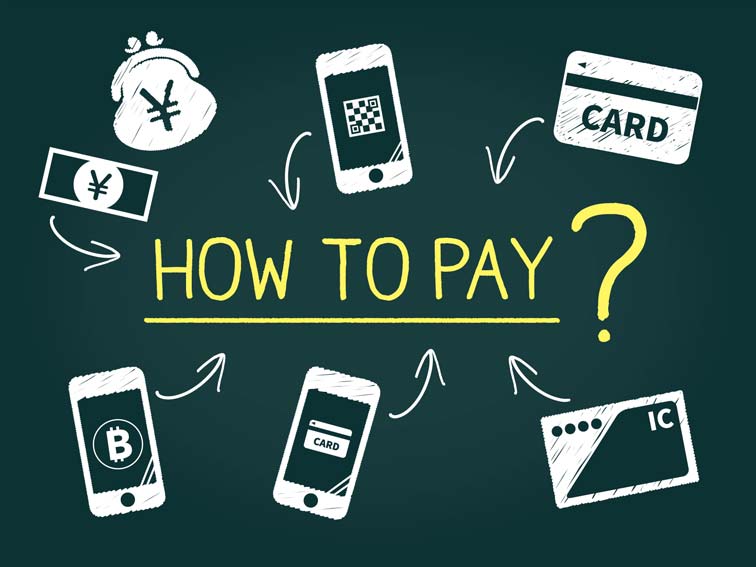Cashless Payment Options in Japan

by Florian
Japan has been a cash-loving society for the longest time. But cashless payments are slowly becoming more commonplace and come with some added benefits. Find out which service is best suited to your needs and learn about the rewards and benefits.
コンテンツ
Japan – a cash society?
Cashless payment is gathering traction worldwide. In 2016, countries such as the UK (68.6%), China (65.8%), or Sweden (51.5%) could already boast a cashless payment rate of over 50 percent, with South Korea (96.4%) being the undisputed top runner. Meanwhile, Japan was lagging at around 20%.
While government plans have been made and new services and options have been shooting up like mushrooms, growth is still slow. According to recent figures, overall cashless use was at around 21.3% in April 2019. This once again proves that Japan isn’t as high-tech as it is often made out to be.
Below, I’ll first explain why this is the case. If you’re just interested in the services that are available, you can skip the next few sections.
Why Japanese love their hard currency
But what are the reasons for the slow spread? The first one is simple: Habit. Japan’s aging population is a big factor here – elderly people tend to stick to the things they already know instead of trying out newfangled stuff like paying with a QR-code. When those elderly people make up over a third of a country’s population, change is bound to be slow.
The low rate of (petty) crime like pickpocketing is another reason. In Japan, things you drop in the street often come back to you unharmed, so people don’t mind carrying around a wallet full of cash all that much.
Also, there are ATMs almost everywhere. Overall, the nearly unhindered access to cash and low amounts of fear of having it stolen reduces many people’s enthusiasm for cashless payment.
Of course, the amount of elderly people who can deal with smartphones has been increasing. But even those who are well aware of cashless payment options often eschew them. Some think using the services would make them lose their grasp on how much money they spend, others feel they’d be helpless upon losing their smartphone.
Finally, there is availability. This is what makes cashlessness a typical “hen and egg” problem. If there aren’t enough stores that support cashless payments, people don’t use the services, which in turn leads to stores making the decision that they don’t need to support cashless options, and so on.
Hurdles to change
In addition to the power of habit, there are also other hurdles of economic, technological and political nature.
Especially for smaller stores, initial and running costs for the technology are big pain points. When asked how they felt about cashless payments in July 2019, 46.3% of small shop owners (that had not introduced cashless payment options at that time) answered they were skeptical of the fees their shops would have to pay.
Then there are the banks. While some of them have (reluctantly) jumped on the bandwagon, many banks are Showa-era behemoths, exceptionally resistant to change. While ATMs are expensive to set up and maintain, most banks make a considerable amount of profit off service fees – up to 99%
even (in the case of Seven Bank).
Another hurdle is security. In this respect, the Japanese cashless industry recently took a big blow. On October 1st, 2019, Seven Pay, the mobile payment app from the company behind the 7-Eleven convenience store chain, was shut down – it had been running for only three months at that point. Almost immediately after the service started, security holes in the app led to fraudulent access to the user’s money.
Japan’s future is cashless
Despite the hurdles, the Japanese government continues its mission to increase the cashless payment rate. The goal is to reach 40% by 2025. In the long term, cashless(ness) is supposed to help with the shrinking workforce, reducing the need for staff in supermarkets, convenience stores, etc.
The topic has been garnering attention in light of the upcoming Olympics. Honestly, sometimes it seems a bit absurd how much focus is being put on this one event. But to Japanese policymakers, 2020 marks a year during which “the world comes to Japan”, leading to the need to show that the country is “keeping up with the times” – or at least creating the illusion of it.
In tandem with the most recent consumption tax increase, the Japanese government made it possible for stores to offer tax returns to customers who pay without cash. While this measure comes with its own batch of problems and hurdles that I’m not going to detail here, it certainly serves as an encouragement.
Now that you know about the background, let me introduce you to the different options for cashless payment in Japan.
Credit and Debit Card Payments
Credit cards are still the No. 1 popular option when it comes to paying cashless in Japan. For many, a major reason for why they don’t try out the new services is that they’re satisfied with their credit card when it comes to cashless payments.
If you want a Japanese credit card, you can find out how to get one here.
That being said, credit card use is still lower in Japan than overseas. Credit card terminals are not a rare sight, especially in stores where payments can quickly lean towards the higher side. Still, you can easily get yourself into scenarios where you’re not able to rely on your credit card.
IC Card Payments
IC Cards are “prepaid” cards – you charge them beforehand and then use them until the money runs out. In Japan, the most widespread cards of this type are the cards used for public transportation such as Suica, PASMO, ICOCA and other regional variants.
While Japan is a laggard when it comes to cashless payments in general, public transportation cards have been widely used for quite some time now. As a result, many shops already offered the option to pay with them well before the government started making its “cashless push”. In urban areas, they offer good store coverage. In the countryside though, not so much.
Many people still use cash to charge their IC cards. However, there are a few options for remote charging, e.g. by coupling your Suica card with Google Pay.
Mobile Payments
Even younger people that are well acquainted with smartphones can find themselves having a hard time getting into cashless payment. One of the main points here is the sheer number of options. The amount of services has been exploding recently, and the fact that almost all of them are named “something something-pay” isn’t helping with keeping them apart and deciding on one.
Most of the services function similarly. First, you download an app, register, and connect it to your credit card. Then you use the app to pay at the store by either scanning a QR code (or barcode) or just holding your smartphone over a terminal.
Below, there’s a list of some popular as well as smaller, but interesting cashless payment services in Japan, with details regarding each one at the time of writing this article (November 2019).
| Service | Spread | Credit Charge | Point Rate |
|---|---|---|---|
| Rakuten Pay | 〇 | Yes | 0,5-5% |
| LINE Pay | ◎ | Yes | 0,5-2% |
| PayPay | ◎ | Yes | 0,5-1,5% |
| Origami | △ | Yes | 1-3% |
| merPay | 〇 | No | 0% |
| D-barai | 〇 | Yes | 0,5-1% |
| Google Pay | ◎ | Yes | Varies |
| Apple Pay | ◎ | Yes | Varies |
| Pixiv Pay | △ | Yes | 0% |
| Pring | △ | No | 0% |
Rakuten Pay
This service is owned by Rakuten – who would’ve thought. Together with LINE Pay and PayPay, it is one of the “big three” mobile payment options.
Setup is simple. You download the app, connect it to your bank account and verify.
The main draw of popular mobile payment apps at the moment are their various point campaigns, and Rakuten Pay is no exception. October 2019 marked the beginning of a big one, offering users an unusually high point return rate of 5% at all stores that support the app. Other campaigns are expected to follow.
With a Rakuten card, you can get twice the number of points. Upon paying with the app, you’ll be awarded Rakuten Super Points (on your credit card) as well as points on the Rakuten Pay app. Some other services coupled with specific credit cards use this system as well. The point return rate goes up to 5% (with a Rakuten Gold card).
Other than paying with the points at the stores that support Rakuten Pay, you’re also able to use them in Rakuten’s Online Shopping portal.
LINE Pay
This mobile payment service is handled by LINE, the company behind the messenger app of the same name.
Setup follows the usual pattern. Download, add bank account and verify. You can set your LINE Pay balance to be charged automatically if it drops below a certain number. Payment is then carried out by either letting a store clerk scan a code on the LINE Pay app or using the app to scan a QR code yourself.
LINE Pay’s point system is tiered. Currently, you’re able to get back up to 2% of your payments in LINE points (2 points for every 100 JPY). However, the 2% rate only applies when you’re buying something with a total value of 100,000 JPY or more. Using the app daily, most of your payments will fall under the 0.5% tier, which applies to purchases below 10,000 JPY.
There are a few different ways in which you can use the points you’ve accumulated. Don’t wait too long to convert them though – LINE points automatically expire 180 days after you got them.
The first (and most straightforward) way is to simply convert the points into Yen for your LINE Pay balance. 1 point is worth 1 yen.
If you’re using LINE’s messaging app (why wouldn’t you be when you’re on LINE Pay anyway), you can also convert your points into coins. Yes, that’s yet another form of virtual currency, on the same platform – wonderful.
The reason is that the rate is different. Instead of 1 yen for each point, you get 1 coin for every two points you convert. You can use the coins to buy LINE stickers, themes, etc.
PayPay
This service is a joint venture by SoftBank and Yahoo! Japan. Currently, you’ll be able to use this payment option at 1.5 million stores across Japan.
Since October 1st, 2019, PayPay is heavily tied to Yahoo! services. Thus, the app is best coupled with a Yahoo! Japan credit card. If you have both, you’ll be able to be awarded 1.5% of your purchase at the store in points (that you can then use to buy more stuff).
If you don’t have a Yahoo! Credit Card, the rate will go down to 1%. Additionally, you’ll only be able to use the points collected this way for certain Yahoo! services such as Yahoo Auctions and Yahoo Shopping. In case you don’t know, Yahoo is pretty big in Japan so it may not be as bad as it initially sounds. It is, however, still limiting.
Origami Pay
Origami Pay is another QR code-based mobile payment service. Using the app, you’ll be able to get points of up to 2% of the total purchase price. Another feature is that you’re able to connect more than one credit card.
As a “true startup” founded in 2012, Origami is not directly tied to a bigger company like Rakuten or Yahoo. On one hand, that means you won’t have to get entangled in other company-specific services to get the full value. However, it also comes with its downsides.
First, according to user reviews, the number of coupons and campaigns run on Origami Pay is lower than other cashless payment services and access to them is more limited.
Additionally, Origami Pay has a lower overall spread. Its store portfolio is by no means small, containing big and popular chains like Loft, Bic Camera, Tsutaya, Muji and Yoshinoya. However, when it comes to convenience stores and supermarkets, Lawson is the only big option. This, among other things, lowers the everyday usefulness of the service.
merPay
merPay is linked to the popular, eBay-like auction site Mercari. When using this service, the money you make by selling things on Mercari will directly be added to your merPay balance. You can then use that money to buy things at the store or on Mercari, closing the loop. Unless there’s a campaign, you also won’t be able to receive points just for shopping with the app regularly.
The biggest difference between merPay and the other options is that you can’t use your credit card to charge your merPay account balance. To get extra money onto your merPay account, you need to make a regular old bank transfer. And to do that, you’ll have to set up online banking for your Japanese bank first…
In the end, merPay is probably only worth it if you’re regularly selling (and buying) stuff on Mercari. For anything else, the other options are a lot more comfortable and easier to set up.
D-barai
D-barai is a cashless payment service set up by NTT Docomo.
The basic point return rate at physical stores is 0.5%. When you’re shopping online, it increases to 1%. You can use these points to pay for things at stores or (parts of) your monthly Docomo phone contract fees, buy extra data volume for your smartphone, etc.
There are three ways to (re)charge you D-barai balance.
The first option is to connect it directly to your credit card. In addition to Docomo’s own d-card, D-barai supports VISA, Mastercard, American Express and JCB. To add the card, you’ll first have to register with the 3D Secure authentication service.
As long as you have a phone with an NTT Docomo contract, you can also couple cashless balance charges with your monthly phone contract fees. In that case, an extra amount of money will be deducted from your bank account every month and added to your D-barai balance.
Finally, you can also use cash to charge your cashless balance. There are no fees attached to charging. For convenience stores, charging is possible at Family Mart and Lawson along some smaller chains (Mini Stop, Daily Yamazaki). There are also some banks offering D-barai charging services, such as Japan Post Bank, Mizuho, and Mitsui-Sumitomo.
Google Pay
As the name says, this is Google’s own cashless payment service. One big difference is that at real-world locations, you use Google Pay in tandem with other cashless payment options that you might already be using. The six available options are Suica, Nanaco, Waon, Rakuten Edy, iD and QuicPay.
In practice, you use Google Pay to remotely charge these cards through your credit card.
For example, you can put some more money on your Suica on the go, without having to use the charging machine at the station. When buying things at a store, you don’t have to mention Google Pay, open apps, scan any codes or get your Suica card out. Just say that you want to pay with Suica and put your phone on the terminal.
Since you don’t use Google Pay in tandem with other services, how many points you’ll be awarded will mostly depend on the card you have registered and the campaigns their companies run. You can check Google’s own campaigns here (in Japanese).
Apple Pay
Apple’s proprietary cashless service largely functions in the same way as Google Pay. The services compatible with it are Suica, iD, and QuicPay.
Also (and in contrast to Google Pay) you can also use the Apple Pay app as a placeholder for the credit card registered with it. That way, you won’t have to get out your credit card at the store counter.
Pixiv Pay
If you like manga and anime, you’ve probably heard of Pixiv. It’s a site similar to DeviantArt or Artstation where artists and illustrators can upload their works for the whole world to see. Pixiv Pay is a niche service optimized for artist conventions like Comiket or Comitia, where artists directly sell their illustrations, self-made manga, etc. to visitors.
On one hand, it makes the shopping experience at those fairs easier by offering the option to pay by QR code scan. At big events like Comiket, there are hundreds of booths, and many visitors take their time wandering around the fairgrounds, buying some postcards here and a comic there. Having to take out your wallet every time can get annoying pretty quick (as someone who’s been to Comitia, I can tell).
On the other hand, Pixiv Pay makes things easier for the artists by lowering the need for a physical box to put money in (and the need for carrying around a big stack of money when the convention is over). There’s also an “assistant function” that enables booth staff to handle payments when the artist (and their smartphone) isn’t around.
If you’re on the selling side, there’s a catch though. The service comes with a 3.6% transaction fee as well as a 200 Yen bank transfer fee. So, if you’re just starting out and don’t have a large fan base yet, sticking to cash might be the better option.
Pring
Pring is another “niche” or “indie” cashless payment service. It’s pronounced the same way as the Japanese word for “pudding” (プリン).
At first glance, the most notable thing about this app is its fancy and simple UI. The service calls itself “the money communication app” and has three basic functions: Sending money, receiving money and paying at stores. It’s the first two that differentiate from other options in this article.
If you’ve ever split the bill (割り勘, わりかん) with a group of Japanese friends after eating out or going to Karaoke together, you probably know how annoying paying can get after the party’s over. There’s always that one person that just has a 10,000 yen bill and has to go to the nearby konbini to have it broken down while the rest of the group is forced to wait.
Pring attempts to solve this problem (and others similar to it) by making it possible to send money to others easily. If the receiver also has Pring, you can just send them the exact amount of Karaoke money without having to fish around your wallet or buying something else first.
While you can use the money received that way to pay at stores, that function is not the app’s strong suit. Pring is the newest service on this list – it was released in March 2018. Since it entered the market so late, it can’t boast support by big store chains. Its spread is almost entirely based on single stores, further increasing its indie feel. You can check a map with all the shops that support Pring here.
If you can’t use the money send to the app, why would you use it? Here, the last main feature comes in. In contrast to most other cashless payment services, sending money back to your bank account from the app is free of charge. So even if there are no Pring-supporting stores near you, you can always just add the received money to your regular savings.
Going Cashless
One can certainly be skeptical about whether the 40% cashless payment rate by 2025 is realistic or not. There are still a lot of hurdles to clear, and (limited) point campaigns won’t solve each and every problem. Either way though, if you’re in Japan and want don’t want to rely on cash as much anymore, now is the time to start.
In addition to recent government programs (most of which will end in 2020), many cashless service providers are still in the stage where they’re “throwing money” at customers to develop a larger user base. Even if you don’t go all in, you will still be able to get the occasional toothbrush or comic for free.
Recommended Posts

May Sickness: A Japanese Phenomenon
10 5月 2021 - Daily Life, Life


